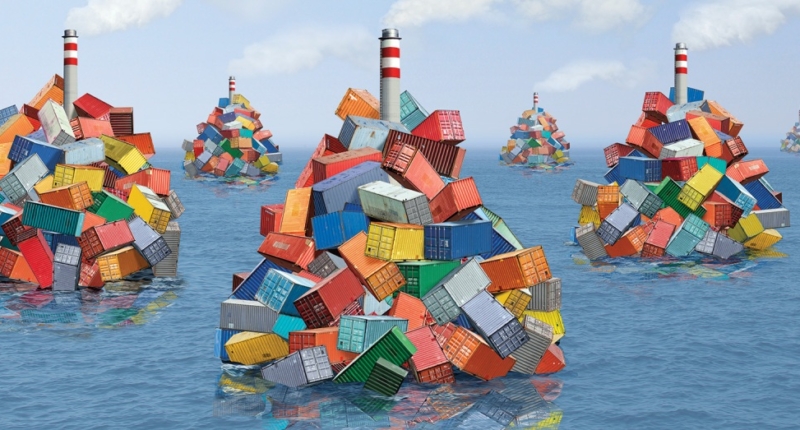The article argues that the United States should pursue a policy that promotes the widespread diffusion and adoption of the best technologies instead of focusing solely on manufacturing production. This would involve purchasing the technologies from abroad and ensuring global standards for innovation and technical progress. The article highlights that a successful U.S. industrial policy is one that increases supply chain resilience, accelerates greener energy, and helps other countries stand up to Chinese threats. The United States should coordinate with other countries on public investment in high tech, reduce barriers to the spread and adoption of the best technologies, and allow others to win or lose any specific game or even season but ultimately shape who plays under what conditions. The article concludes that the current shortsighted self-dealing policy will do more harm than good for U.S. economic and national security and that a commissioner’s role in the global economy is an industrial policy that would work.
America’s Misguided Industrial Policy
The Biden administration continues to prioritize bringing manufacturing production back to the United States, following the lead of the previous administration. While this policy approach is popular among the public, it is based on several erroneous assumptions.
Four fallacies underlie this policy approach: the belief that self-dealing is intelligent; that self-sufficiency is achievable; that more subsidies are better; and that local production is paramount. These assumptions contradict two centuries of well-researched history of foreign economic policies and their effects. The real but overstated threat from China, as well as the differences between today’s technology and past innovations, do not alter the underlying realities.
Industrial policy, such as government subsidies and protections to boost domestic capacity in a favored sector, is nothing new in global economic history, and it can be beneficial. While the Biden administration’s renewed investment in public infrastructure, research, and innovation is welcome, the protection and promotion of U.S.-located manufacturing against foreign competition is not necessary for industrial policy’s success, and it may undermine the very purpose of it.
While some Chinese policies, including economic ones, are aggressive and pose a threat to human rights and democratic sovereignty, their direct impact on U.S. economic security is overstated. Commerce with China has yielded significant benefits, and many of China’s supposed self-serving, even cheating, tactics in trade have backfired. Subsidizing steel, for instance, has contributed to environmental degradation and an uncompetitive workforce, resulting in vast overcapacity rather than success for China.
Targeted export and investment controls on China, Russia, and other military rivals in a limited number of well-defined high-tech goods could be sustainable and worth the economic cost. However, protectionism against foreign competition is not necessary for industrial policy’s success. Shutting off from the world will have consequences, and attacking international trade and investment as harmful to U.S. economic and national security disregards the fact that the U.S. established the rules for that very system and that it serves its interests.
In conclusion, while industrial policy and subsidies can be useful, shutting off from the world will have consequences. Targeted export and investment controls on certain countries could be sustainable and worth the economic cost. However, prioritizing the relocation of manufacturing production back to the United States and attacking international trade and investment is based on erroneous assumptions and may undermine the purpose of industrial policy.
Economic Decoupling from China: Costs and Consequences
U.S. policymakers face challenging questions concerning the Chinese threat to U.S. security. What economic tools could effectively counter Chinese military aggression, and what are the costs of economic decoupling from China? Further decoupling would not only impact U.S. consumers and businesses but also U.S. military and intelligence capabilities, including access to Chinese technologies and intelligence derived from commercial engagement with Chinese companies. Additionally, the United States would have fewer resources to spend on defense and information-gathering since everything acquired abroad would be more expensive, including capital to finance government debt.
A unilateral U.S. withdrawal from commerce with China would be offset by other economies taking up market share where the United States no longer operated. This would increase arbitrage opportunities for other countries and for companies headquartered elsewhere to trade and invest where the United States ceased to do so.
U.S. attempts to impose arbitrary export and investment restrictions on China that extend to other countries would not address the Chinese threat and would backfire. For such restrictions to succeed, the United States would have to become a commercial police state on an unprecedented scale, monitor and prevent its own companies from moving activities abroad, and limit the spread of technology. U.S. industrial policy should encourage the widespread adoption of the best technologies at home and abroad rather than favoring localized domestic production.
The Chinese threat is best confronted by diplomacy and defense capabilities. Aggressive behavior from Beijing should not be taken out on private Chinese companies that have had commercial success. Doing so will hinder technological progress and erode the United States’ influence on third countries. While the lack of quick wins may be frustrating, taking that frustration out on the rest of the world will make U.S. security worse.
The Pitfalls of a Protectionist Industrial Policy
For a long time, the United States has acted as the creator and enforcer of international economic rules, without visibly and directly picking winners or losers in a given industry. By acting within the system to constrain countries’ specific behaviors, the U.S. benefited from maximum economic traction while minimizing the need for direct conflict. However, the current economic and trade strategy of calling out individual countries, complete with tit-for-tat retaliation for perceived or actual slights, defeats the goal of reordering the economic system, whether to limit China’s military power or speed up adoption of green technologies. It also throws away the United States’ status as the leader of a rules-based system.
A protectionist industrial policy that encourages discriminatory manufacturing subsidies, and only allows China to compete, sends a message to the rest of the world that their aspirations for development do not matter. This would mean that countries in the developing world would have to go cap in hand, government to government, to get access to one nation-state’s products, let alone be a part of the production process. The ability of individual companies in developing economies to earn investment on merit would be sharply diminished, which would disincentivize growth and breed justified resentment.
The United States risks becoming just another player in the game, with no justification for its self-dealing and no reason for other countries to stay on its good side beyond one-off transactions. This transactional view of economic relationships could defeat the goal of reordering the economic system to limit China’s military power or speed up adoption of green technologies.
In the news, supply chain issues have been at the forefront, and it is tempting to join a side rather than oversee the whole. However, this is shortsighted, and instead, a broader view is necessary.
In conclusion, the current protectionist industrial policy may result in short-term gains but risks losing the U.S. status as the creator and enforcer of international economic rules. A broader view is necessary, which includes working within the rules-based system, avoiding transactional economic relationships, and not allowing discriminatory manufacturing subsidies that exclude developing economies.
Why “Buy American” Policy is Flawed and Misguided
The “Buy American” policy has gained traction in the United States, with proponents arguing that it promotes self-sufficiency and prioritizes American workers. However, studies show that policies aimed at maximizing domestic manufacturing employment, rather than promoting innovation, national security, and decarbonization, will likely fail. Such policies crowd out industrial and trade policies that are more effective and efficient.
Recent supply chain issues, such as the shortage of semiconductors, have prompted the Biden and Trump administrations to invest in local production. However, market economies are designed to adapt quickly to shortages, and dominant suppliers seldom boycott selling to customers. Moreover, stockpiling strategic reserves and trading with other countries are more effective responses to shortfalls in supply, rather than investing in local production.
Take the European Union’s response to stoppages in oil and gas supplies after Russia’s invasion of Ukraine. Eurozone economies adapted to higher and more volatile energy prices far more rapidly than expected. Prices even dropped after European economies reduced their demand for supply. In 1973, after a Saudi-led oil embargo, Western economies shifted production and consumption patterns within a couple of years. In short, market economies are more resilient and less dependent on dominant suppliers than proponents of extreme U.S. industrial policy suggest.
While a supplier with malevolent intent can cause pain via temporary shortages, stockpiling strategic reserves and turning to trade with other countries can address these issues more effectively than investing in local production. Russia’s attempts to weaponize Europe’s dependence on its oil and gas supplies were unsuccessful in the long term. Putin’s attempts to cut off gas from the Nord Stream 1 pipeline in mid-2022 did not prevent Europe from reducing its dependence on Russia while strengthening its support for Ukraine. Market economies’ resilience is much greater, and suppliers’ ability to extract concessions much less, than the scaremongering used to justify extreme U.S. industrial policy would suggest.
Conclusion
Investing in local production to promote self-sufficiency and prioritize American workers might seem appealing. However, studies have shown that such policies crowd out more effective industrial and trade policies that promote innovation, national security, and decarbonization. In the face of supply chain issues, market economies are designed to adapt quickly to shortages, and strategic reserves and trade with other countries are more effective responses than investing in local production. Market economies are more resilient and less dependent on dominant suppliers than the proponents of extreme U.S. industrial policy suggest.
Investing in local production capacity to create jobs is not the best approach, as it merely shifts jobs from one location to another. Rather, it is necessary to draw workers with relevant skills from other U.S. employers or increase immigration, which is unlikely in today’s political climate. The U.S. industrial economy has many job vacancies relative to the available workers, with notable shortages in the employees needed for the production of semiconductor chips and their components.
Furthermore, “Buy American” policies actually cost jobs by raising the costs of government purchases, reducing the value for taxpayers’ money. They also cost U.S. sales in foreign markets and erode the competitiveness of U.S. goods. Restrictive domestic content requirements in the United States-Mexico-Canada Agreement are reducing the amount of car exports from North America while promoting investment by U.S.-headquartered auto companies in China to reach that market.
While decarbonization is an important goal, green subsidies races lead to the perpetuation of corruption, stifling innovation instead of converging on best practices. It is misguided to start a subsidies contest with the EU.
A better solution for shortfalls in supply is strategic reserves and trade with other places, as dominant suppliers almost never boycott selling to customers, and market economies adapt quickly to shortages. For instance, the European Union adapted rapidly to stoppages in oil and gas supplies after Russia’s invasion of Ukraine, and in 2022, Putin’s cut off of gas from the Nord Stream 1 pipeline induced Germany and other European economies to reduce their dependence on Russia while strengthening Europe’s support for Ukraine. In an actual war situation, market economies’ resilience is much greater than the scaremongering used to justify extreme U.S. industrial policy would suggest.
Therefore, policies aimed at maximizing domestic manufacturing employment rather than the development and adoption of new technologies are doomed to fail and crowd out the very industrial and trade policies that contribute the most to innovation, national security, and decarbonization.
The Harmful Effects of National Subsidies for Strategic Industries
National subsidies for strategic industries have long been a favored tool of governments for supporting domestic manufacturing and employment. However, they are not without negative consequences. This article discusses how such subsidies can lead to limited innovation, inadequate supervision, and corruption.
The Airbus-Boeing Conflict
The Airbus-Boeing conflict is a classic example of how national subsidies can lead to limited innovation in strategic industries. Both the EU and the United States have repeatedly deemed airframe manufacturing a strategic industry, resulting in both sides heavily subsidizing their respective champions. However, the outcome has been limited innovation in passenger aircraft, energy usage, or changing transport paradigms. Instead, subsidies have created an incentive for incumbents to maximize current production, rather than to innovate disruptively.
Moreover, these companies have become too important to fail, resulting in inadequate supervision. Airbus and Boeing have exploited this fact by putting both the underlying system and many of their customers at risk of devastation. If semiconductor or other subsidized manufacturers were to become too big to fail, they are likely to respond similarly.
Negative Consequences
National subsidies for strategic industries have additional negative consequences beyond the risks of monopoly power, undersupervision, and corruption. By adding a political tenor to the allocation of supply chains, they can lead to supply chains that are designed to pursue neither efficiency nor resilience, but instead forge political and security relationships. This can make supply chains more fragile and vulnerable to changing political relationships, and escalate trade disputes that slow commerce and block useful forms of cooperation among nations.
Conclusion
National subsidies for strategic industries may have populist appeal, but they can do more harm than good. Governments should recognize that they can lead to limited innovation, inadequate supervision, and corruption, and that they add a political tenor to the allocation of supply chains. The Airbus-Boeing conflict illustrates these points, resulting in recurrent trade and legal disputes that have impeded EU-U.S. cooperation on a range of adjacent issues. It is important for governments to carefully consider the negative consequences of such subsidies and look for alternatives that prioritize innovation, efficiency, and resilience in supply chains.
Nationalism in Agriculture: An Example of the Damage Done
Agriculture is the most subsidized industry in advanced economies, and this has resulted in far from ideal outcomes. Agriculture subsidies have led to national barriers that prevent the uptake of innovation. For instance, the EU’s imposition of standards against genetically modified organisms (GMOs) has blocked their adoption in large parts of the world. Although some of the fears against GMOs may be genuine, many of them are merely European agricultural interests using vague fears as an excuse to block competition from US exports. As a result, developing countries are forced to choose between accepting viable crops and food aid from either the US or the EU.
Green Energy Transition and Subsidies Duel
The harms of the dueling subsidies dynamic are particularly bad for accelerating a green energy transition. For new energy technologies to displace older ones, they need to be adopted on a large scale. Differences in energy performance among technologies matter materially for outcomes in adapting to climate change. Therefore, when a given technological standard is set and in wide use, the impact of lagging efficiencies compounds.
Domestically favored producers in the EU, US, or China would not necessarily have a monopoly on good ideas for decarbonization technology. Global competition and innovation are needed, as with vaccines. However, shutting oneself off, insisting on local production of indigenous technology, as China and Russia did in developing their COVID-19 vaccines, has vast consequences. In a subsidies duel, national-champion companies and their captured governments will use differing standards to set up barriers to entry for foreign-produced products.
Counterproductive for Resilience and Adaptation
More than food or airplanes or vaccines, having energy grids, batteries, and innovative technology for transportation or heating, ventilating, and air conditioning separated into autarkic networks will be counterproductive for resilience and adaptation. Subsidies contests lead to a perpetuation of corruption, which, in turn, stifles innovation. In addition, undersupervision, corruption, and the risks of monopoly power apply especially to companies insulated from both domestic and international competition. Therefore, setting up national subsidies for strategic industries does more harm than good as they add a political tenor to the allocation of supply chains.
The Importance of Technology Adoption for National Security and Climate Change
The current subsidies competition between the US and the EU is an obstacle for decarbonization. It creates a dynamic where third countries are forced to choose between European and US technologies for their energy systems, hindering decarbonization. The problem is that the best technology may not win, and the adoption of such technologies may not happen fast enough. Emerging economies, including large carbon emitters such as Brazil, India, Indonesia, Mexico, and China, will be forced to choose between technologies, which will directly impede decarbonization.
Public Investment in Research and Infrastructure
The best way to promote the widespread adoption of common technologies that reduce vulnerabilities to supply conditions, Chinese intelligence incursions, and dependence on carbon-based energy is through extensive public investment in research and infrastructure. By encouraging global competition and the spread of technologies, industries such as batteries, cyber defense, and vaccine manufacturing can benefit from such investment.
Technology Production vs. Adoption
It is crucial to distinguish technology production from technology adoption. Public investment in technology production can be both productive and wasteful, but it is nothing new for the US. However, such policies will not bring about transformative change in US competitiveness, accelerate economic growth or job creation beyond an initial spending bump, or reduce income inequality. Such policies may be helpful, but they are far from transformative.
The Importance of Technology Adoption
To see the real impact of technology, one only needs to look to the 1990s when US companies and the military adopted information technology across the economy. This adoption resulted in a surge of US productivity (and defense capabilities). Shippers were tracked, inventories were monitored and restocked, repetitive tasks were automated, and job descriptions changed mostly for the better.
The Single Best Thing the US Can Do
The single best thing the US can do to advance its national security and climate change goals is to support the widespread adoption of common technologies. This will reduce vulnerabilities to supply conditions, dependence on carbon-based energy, and Chinese intelligence incursions.
The Importance of Technology Adoption over Production for Economic Growth
In the global economy, technological adaptation and adoption are essential for economic growth, national security, and climate change mitigation. This is especially true for common technologies that can reduce vulnerabilities to supply conditions, dependence on carbon-based energy, and cybersecurity breaches.
The Importance of Technology Adoption
The United States experienced a significant leap in productivity in the 1990s because of its business practices and new offerings, not because of computer or chip production. This highlights the general rule of economic development that growth comes from economywide adaptation of general-use technologies, not the production of particular products.
Furthermore, Europe, Japan, and China all lagged in productivity despite their protectionist industrial policies on behalf of local information technology producers. To close the productivity gap, they needed to import new technologies and best practices from abroad, but their obsessions with their own manufacturing hindered that adaptation.
The Downside of Domestic Production
Attempts to increase domestic production of technologies, without already having a leading industry, generally backfire. For example, China’s major effort to create indigenous semiconductor production, even before U.S. export restrictions, left it unable to produce cutting-edge chips. China’s chips industrial policy project also wasted billions of dollars, diverted engineers from other activities, and resulted in corruption by managers and officials. As a result, China failed to catch up or create widespread innovative use of the latest chips in the economy.
The Single Best Thing the United States Can Do
The United States can best advance its national security and climate change goals by supporting the widespread adoption of common technologies through public investment in research and infrastructure. This would encourage global competition and the spread of technologies in relevant industries such as batteries, cyberdefense, and vaccine manufacturing.
Public investment in producing technology can sometimes be productive, but it is much less the production than the adoption of technology that ensures national security and can slow climate change. For instance, genetically modified organisms (GMOs) offer great promise for health and nutrition enhancement globally. However, the EU’s standards against GMOs prevent their adoption in large parts of the world, blocking competition from U.S. exports.
Conclusion
To achieve economic growth, national security, and climate change mitigation, technological adaptation and adoption are essential. This requires a focus on the economywide adoption of general-use technologies, rather than the production of particular products. The United States can best achieve this by supporting the widespread adoption of common technologies through public investment in research and infrastructure, encouraging global competition and the spread of technologies in relevant industries such as batteries, cyberdefense, and vaccine manufacturing.
The Pitfalls of National Industrial Policies
National industrial policies are often viewed as a means to promote economic growth and national security by nurturing domestic industries through subsidies and trade barriers. However, as we have seen in the past, such policies often fall short of their intended goals.
Lessons from Past Experiences
Countries such as China, Japan, and France have all attempted to nurture their local technology industries through protectionist policies, only to fall behind the United States in terms of innovation and technological sophistication. As it turns out, growth comes from the economy-wide adoption of general-use technologies rather than the production of particular products.
The Importance of Technology Adoption
In the 1990s, U.S. productivity surged due to the widespread adoption of information technology across various industries. This surge in productivity did not come about because of U.S. production of computers or chips; rather, it was due to the U.S. transforming its business practices and creating new offerings that made full use of the new technology. In contrast, Europe, Japan, and China failed to adopt and adapt to the same extent as the U.S., hindering their productivity growth.
The Need for Global Standards
Accelerating innovation and technical progress requires common standards at a global scale, not politically captured industries with barriers to entry. Disregarding global realities of technology and trade in the pursuit of a zero-sum approach to manufacturing production will harm U.S. economic and national security interests in the long run.
A Successful U.S. Industrial Policy
A successful U.S. industrial policy should promote the widespread diffusion and adoption of the best technologies, even if that means purchasing them from production located abroad. Innovation and technical progress are accelerated by having common standards at a global scale.
The Best Path Forward
To achieve supply chain resilience, sustainable income gains for American workers, defense against Chinese aggression, and acceleration of greener energy, discriminatory aspects of recent legislation must be corrected. The U.S. government should promote global competition and the spread of technologies in relevant industries such as batteries, cyber defense, and vaccine manufacturing. The U.S. should also encourage joint ventures with foreign firms in key industries where a U.S. producer does not exist, instead of forcing them into partnerships with U.S. firms.
In summary, pursuing a zero-sum approach to manufacturing production through protectionist policies may seem like a quick fix, but it will do more harm than good for the U.S. in the long run. A successful U.S. industrial policy should prioritize the adoption and diffusion of the best technologies globally, promoting competition and spreading technologies in key industries.
Washington should restrict a narrow list of militarily important technologies that shouldn’t be exported to China and the United States should avoid dependence on Chinese production for them. Cooperation with the EU, Japan, South Korea, and Taiwan on public investment in high tech, rather than competing with them, is better. This would remove commercial conflict and reduce barriers to the adoption of the best technologies. The United States should adopt a commissioner’s role in the global economy and allow others to win or lose any specific game or even season but ultimately shape who plays under what conditions. This would be a more effective industrial policy rather than the current shortsighted self-dealing approach.
Don’t miss interesting posts on Famousbio










